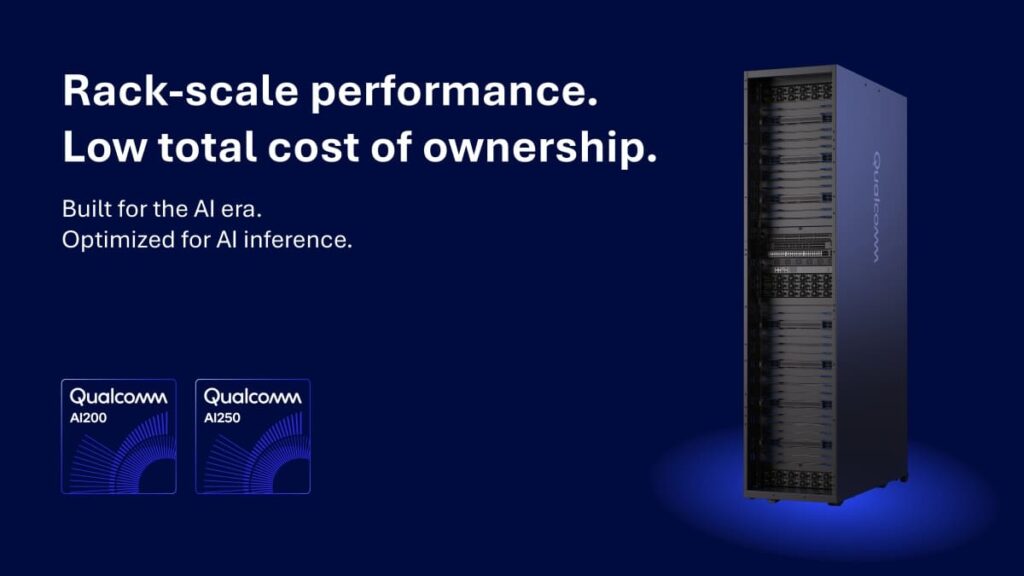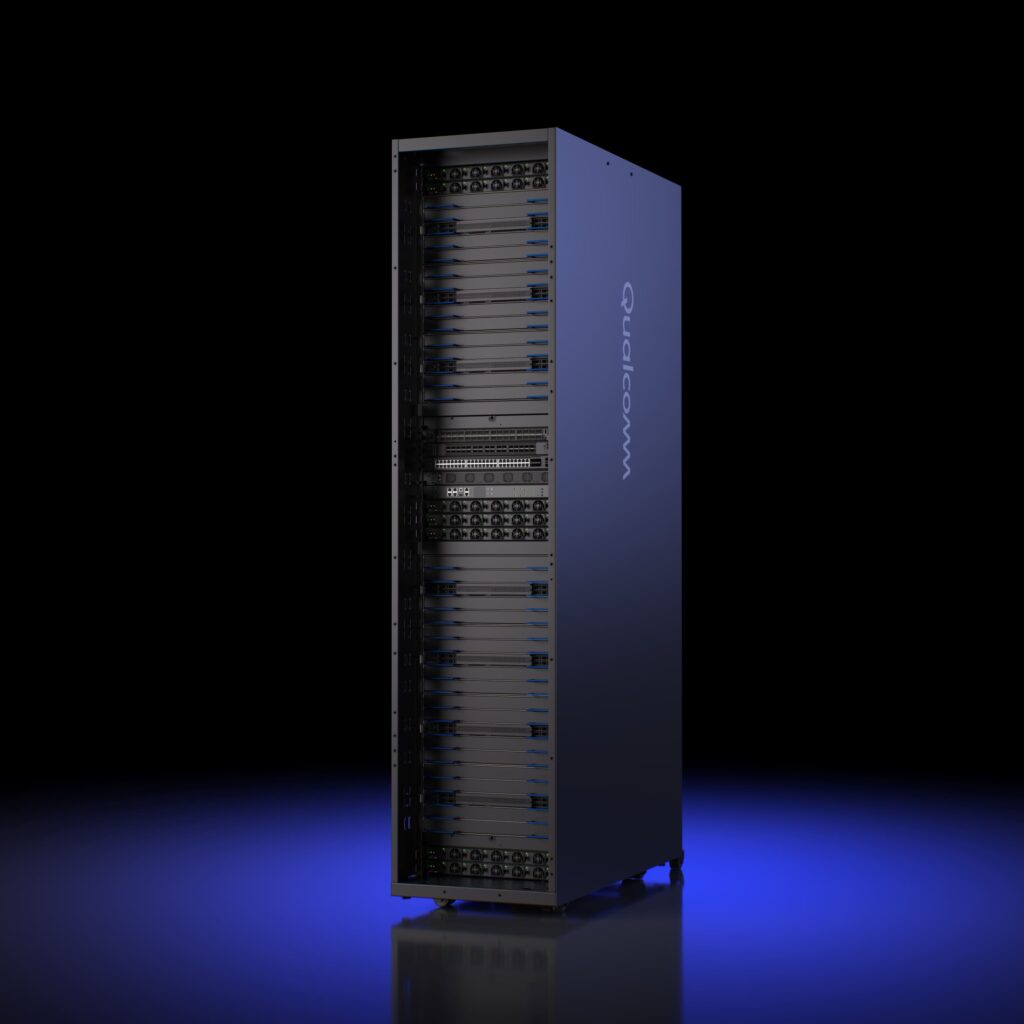Qualcomm has made a major move in the race for AI inference in data centers. The company announced AI200 and AI250, two acceleration solutions sold as cards and full racks, promising rack-scale performance, superior memory capacity, and a leading Total Cost of Ownership (TCO) for deploying generative models (LLMs and LMMs) with efficiency per euro/watt without compromising security or flexibility. The focus, beyond raw power, is on what the industry demands right now: serving pre-trained models at the lowest cost, with high hardware utilization, low latency, and a software stack designed for operationalizing AI.
“With AI200 and AI250, we are redefining what’s possible in rack-scale AI inference. These solutions enable generative AI deployment with unprecedented TCO, maintaining the flexibility and security required by modern data centers,”
said Durga Malladi, SVP & GM of Technology Planning, Edge Solutions & Data Center at Qualcomm Technologies.
The offerings are available in staged releases: AI200 is expected in 2026, and AI250 in 2027, part of a multi-generational roadmap with an annual cadence that Qualcomm emphasizes—focusing on inference performance, energy efficiency, and TCO.
Two paths to the same goal: large-scale generative inference
AI200: rack-level AI inference with more memory per card
Qualcomm AI200 is described as a rack-scale inference solution aimed at low TCO and high performance per dollar per watt. Notably, it offers: up to 768 GB of LPDDR per card, a figure that triples or quadruples the typical local memory in many current accelerators, designed to accommodate long contexts and larger batches without penalizing performance due to capacity constraints.
- Memory: 768 GB LPDDR per card for cost-effective capacity.
- Target: inference of LLMs and multimodal models (LMMs) with scalability and flexibility.
- Scale: cards and full racks capable of scaling up (PCIe, scale-up) and scaling out (Ethernet, scale-out).
- Cooling: direct liquid cooling in racks to improve thermal efficiency.
- Security: confidential computing to protect data and workloads during execution.
The combination of large-capacity LPDDR and PCIe for scale-up hints at a design where more memory per accelerator reduces costly exchanges with external memory, thereby lowering latency and power consumption. This is critical when the bottleneck in inference isn’t just compute but also the rapid feeding of tokens and activations.
AI250: “near-memory” memory architecture for a generational leap in effective bandwidth

The most disruptive part is Qualcomm AI250, debuting with an architecture based on near-memory computing. Its declared goal: a generational leap in efficiency and performance for inference through more than 10× effective bandwidth and lower power consumption. Translated: bringing compute and data closer together to minimize transfers and better leverage each watt.
- Near-memory computing: compute close to memory to amplify effective bandwidth (>10×).
- Energy efficiency: less power per token served.
- Disaggregated inferencing: more flexible separation of components (model, memory, compute) to achieve better hardware utilization.
- Goal: meet performance needs with lower costs and power consumption compared to monolithic solutions.
If AI200 tackles capacity (more memory per accelerator, more context per card), AI250 aims at the feeding speed (feeding the beast) that now chokes large models: without enough memory bandwidth, compute remains underutilized. Qualcomm’s near-memory approach addresses this gap.
Rack-ready solutions: 160 kW, PCIe, Ethernet, and security by design
Both solutions are also offered as full racks, ready for multi-scale deployment:
- Direct liquid cooling: higher density with less thermal penalty.
- PCIe (scale-up): group resources within a node with low latency.
- Ethernet (scale-out): scale across multiple nodes using standard data center protocols.
- Confidential computing: encrypted and isolated workloads during execution, essential for sensitive data AI.
- Power: up to 160 kW per rack, consistent with modern densities for large-scale generative inference.
The dual-scale architecture (PCIe inside, Ethernet outside) offers modularity: scale by node when increasing scale-up (more memory and compute per accelerator) or by rack for scale-out (more instances serving in parallel).
Hyperscaler-grade software stack: from onboarding to “one-click” deployment
Qualcomm complements the hardware with a end-to-end software stack, from the application layer to the system, optimized for inference and compatible with leading machine learning frameworks. The aim is to minimize friction:
- Frameworks and runtimes: support for inference engines, generative frameworks, and optimization techniques for LLMs/LMMs, including disaggregated serving strategies.
- Model onboarding: seamless incorporation and one-click deployment of models from Hugging Face via Efficient Transformers Library and Qualcomm AI Inference Suite.
- Tools: ready-to-use applications and agents, libraries, APIs, and services to deploy models into production (observability, management, scaling).
This in practice means less ad-hoc porting, less time from POC to production, and greater reuse of the dominant ecosystem—a key point in a market where companies aim to leverage trained models without reinventing the entire stack.
Why it matters: memory, TCO, and the “new economy” of inference
1) Capacity and bandwidth serve context length
The 768 GB of LPDDR per card (AI200) and the >10× effective bandwidth (AI250) address the two bottlenecks currently hampering generative inference: insufficient memory for long contexts and slow feeding of compute. If data doesn’t arrive on time, theoretical FLOPs don’t translate into served tokens.
2) TCO per token
The key metric in production isn’t FLOPs, but cost per response. More cost-efficient memory per accelerator and less power per token thanks to near-memory are Qualcomm’s solutions to lowering the cost per request, the metric platform managers care about.
3) Operational flexibility
Disaggregated serving and the dual scaling approach (PCIe inside, Ethernet outside) enable allocating resources based on the model and load: more memory for extensive contexts, more compute for concurrency, and more nodes for multi-tenant setups, all while maintaining confidential computing for sensitive data.
4) Adoption pathway
Since the software aligns with existing frameworks and Hugging Face’s deployment in a single click, it reduces the cost of change for teams. It’s about better serving what they already have, rather than reengineering everything.
Schedule and roadmap
- AI200: commercial availability expected in 2026.
- AI250: commercial availability expected in 2027.
- Roadmap: annual cadence focusing on inference performance, energy efficiency, and TCO.
The timing aligns with market expectations: from 2026 onward, major clients will scale generative AI in production and look for optimized platforms to serve large-scale models with predictable costs.
Remaining challenges and questions
- Performance validation: the >10× increase in effective bandwidth in AI250 is significant; industry will want comparable benchmarks (end-to-end) and real workloads (LLM/LMM with batching, speculative decoding, KV-cache).
- Rack-scale energy efficiency: 160 kW per rack demands well-managed density and cooling; direct liquid cooling mitigates, but operational factors will be key to justifying the TCO.
- Ecosystem compatibility: the promise of “one-click” deployment over Hugging Face and leading frameworks is ambitious; support for new techniques (e.g., mixture-of-experts, RAG with external indexes) must be sustainable long-term.
- Security: pushing for confidential computing is vital; regulated audiences will require certifications, isolation, and integrations with existing KMS and SIEM solutions.
Who is this for
- Hyperscalers and large cloud providers aiming to disaggregate AI inference to maximize utilization and reduce TCO per token.
- SaaS providers with heavy Generative AI workloads (assistants, semantic search, copilots) seeking scalable solutions with predictable latency and cost control.
- Regulated enterprises requiring confidential computing and on-premise or co-located deployments without sacrificing standard frameworks.
Frequently Asked Questions
What is near-memory computing and why does it improve LLM inference?
It is an architecture that brings computation closer to memory, reducing data transfers. For LLMs and LMMs, where the main bottleneck is often memory bandwidth, this can result in >10× effective bandwidth (according to Qualcomm) and lower power consumption per token.
What advantages does 768 GB of LPDDR per card (AI200) offer?
More local capacity enables longer contexts, larger batches, and less external memory exchange, decreasing latency and power consumption, and improving cost per response in deploying large models.
How do Hugging Face models work with AI200/AI250?
Qualcomm’s stack supports seamless onboarding and one-click deployment via Efficient Transformers Library and Qualcomm AI Inference Suite, with support for leading frameworks and disaggregated serving techniques.
When will they be available and what are the main differences between AI200 and AI250?
AI200 is expected in 2026, focusing on memory capacity and TCO. AI250 will arrive in 2027 with an architecture based on near-memory computing, promising a >10× leap in effective bandwidth and energy efficiency for inference, according to Qualcomm.
via: Qualcomm

